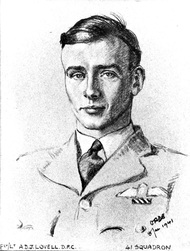Association blog
 January 1941 – As the new year dawned, the Battle of Britain was over. Analyses were being undertaken by the RAF, conclusions made and lessons learned. During this month, 11 Group’s squadrons claimed just 18 victories: seven destroyed, four probable and seven damaged, of which 41 Squadron claimed one probable and one damaged. This stands in stark contrast to the numbers claimed during the height of the Battle of Britain, when almost 200 were claimed in all three categories in just one day. In fact, 41 Squadron claimed more than the month’s total in just one day in September 1940. However, the poor winter weather that prevailed throughout the month did not help the cause, and 41 Squadron flew only 16 patrols on nine days out of 31: there was no operational flying on 6-7, 11-21, and 23-31 January. The month’s monotony was only broken by combats on two of these patrols, both of which resulted in victory claims for the pilots. These were, however, the first since 27 November 1940, and the last for another two months. The former of these claims was made during the RAF’s first ever Circus operation, on 10 January, and the latter in a chance interception during a routine patrol on 22 January. On the latter of these two dates, the morning broke to 10/10ths cloud between 1,000 and 2,000 feet, but soon started to lift and broke to between 6/10ths and 3/10ths with moderate visibility in a southwesterly wind at 5-10 mph. As a result of the improved weather, both the RAF and Luftwaffe were active today, and the Luftwaffe sent approximately 70 reconnaissance aircraft across the Channel to England. The RAF responded well and five victories were claimed by 11 Group, the largest single daily score in some time. For their part, 41 Squadron had a few sections in the air on practice flying, as well as two operational patrols, the first by six pilots between 09:10 and 10:20, and the second, by a pair between 09:50 and 11:10. Whilst the latter was uneventful, the former resulted in an interception and a shared victory for Flt Lt Tony Lovell and Plt Off ‘Hawkeye’ Wells. Green and Blue Sections took off at 09:08 for practice flying, but at 09:35 Green Section was ordered to intercept a lone enemy aircraft, designated ‘Raid 17’. After several vectors, the pilots had still not sighted the aircraft but were nonetheless following its path some distance behind it. Hearing this in progress, Blue Section (Lovell P7612 & Wells P7284), who were then off Southend, called up the Controller and offered their assistance. This was readily accepted and they were advised that the enemy aircraft was now over Clacton. The pair turned north and flew up the coast until Wells finally sighted a bomber some distance north of them, flying on a southeasterly course at 7,000 ft in a 3,000 ft gap between two cloud layers. Wells closed, with Lovell behind him in line astern, and soon recognised the aircraft as a He111K with standard camouflage, but with blue and white spinners, and a large bomb slung underneath it. The pair also noted that the bomber “looked old and battered”. Their approach was perfect, and the sun was behind them as they closed head on. The time was 09:45 and their location was approximately 20 miles northeast of Southend.
Using standard reflector sights, with settings of 40 and 60 feet, the two pilots executed a simultaneous attack, opening fire at 500 yards and closing to just fifty in one-and-a-half to two seconds of fire. However, neither achieved any visible results. Passing the aircraft down its port side as it dived for cloud, Wells turned for a second attack from astern; Lovell passed the Heinkel down its starboard side and turned for a beam attack. Wells fired at the bomber twice for three seconds, the first burst at 300 yards and the second at 100, this time observing rounds entering the fuselage and seeing the crew jettison their bomb into the sea ten miles off Foulness Island. Lovell’s second attack consisted of a single one-second burst at between 500 yards and 50 yards, but he did not see any results. The Heinkel then disappeared into cloud cover and was not seen again, despite a lengthy search. The pair then returned to Hornchurch, put down at 10:17, and claimed the aircraft shared damaged. Wells had expended 1,200 rounds, and Lovell 400. This constituted the Squadron’s last victory for two months, and the last operational patrol for January. [Excerpts from "Blood, Sweat and Courage" (Fonthill, 2014). Sharing permitted, but no reproduction without permission, please.]
0 Comments
Leave a Reply. |
Photo Credit:
Rich Cooper/COAP Association BlogUpdates and news direct from the Committee Archives
August 2022
Categories
All
|
